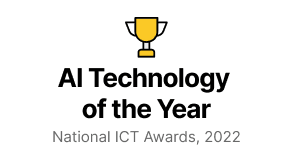Vihindi Kotalawala
2025-05-14
Introduction
The promise of artificial intelligence often evokes images of massive cloud computing infrastructures, where powerful servers process vast amounts of data to drive innovation across industries. However, as AI applications become more deeply integrated into our everyday environments - from smart cities to autonomous systems - there’s a growing need to bring AI closer to where data is generated rather than relying solely on distant cloud servers.
Imagine standing at a busy intersection in a modern city. Traffic lights adjust their timing based on real-time traffic flow, reducing congestion and cutting average commute times. Nearby, smart streetlights automatically dim when no pedestrians are present, saving energy while maintaining safety. Environmental sensors with on-device inferencing monitor air quality, enabling immediate responses to pollution spikes. Every second, massive amounts of data are being processed from various sensors embedded in the urban environment. These systems must operate with millisecond-level latency to optimize traffic flow, improve energy efficiency, or issue alerts about hazardous conditions.
At the heart of this ecosystem are edge devices. An edge device is any piece of hardware that performs data orchestration (the process of managing the collection, transformation, routing, and prioritization of data) at the boundary between networks. These range from routers, gateways, and industrial controllers to IoT devices, embedded processors, and even smartphones, all operating where data is generated. The exponential growth of connected devices has accelerated this trend. With billions of IoT devices deployed worldwide generating unprecedented volumes of data, transmitting everything to the cloud has become impractical, creating bandwidth bottlenecks and unacceptable latency. To address these challenges, processing must happen locally for real-time decision-making without the round-trip latency to cloud servers.
Edge AI transforms these devices from simple data collectors into intelligent agents capable of analysis, prediction, and autonomous decision-making within split seconds. In healthcare, wearable monitors are able to analyze patient vitals in real-time, alerting doctors to critical changes. In manufacturing, machine vision systems inspect products without cloud connectivity.
However, there is a fundamental obstacle in this transformation; edge devices are inherently constrained by limited computational resources, memory capacity, and power availability. Running sophisticated AI models designed for data centers on these constrained devices presents significant technical challenges. How can we deploy complex neural networks on hardware with a fraction of the resources they were designed for?
This is where model compression techniques become vital. Model compression is a technique which systematically reduces complexity of models, so they use less memory and computing power while preserving their accuracy. These techniques bridge the gap between resource-hungry neural networks and resource-constrained edge devices, making edge AI practical across diverse applications.
In this article, we will explore the various model compression techniques that make this possible, including pruning, quantization, knowledge distillation, and the exciting realm of quantum compression algorithms.
Integrating Hardware, Libraries, and Model Compression for Efficient Edge AI
Edge devices operate in environments with stringent resource constraints—limited processing power, memory capacity, and energy availability. Consider security cameras that must process video footage in real time, managing large volumes of data while maintaining low power consumption, minimal latency, and consistent performance. Whether it’s environmental sensors in smart cities or wearable medical devices, these edge systems must perform complex AI tasks locally and in real time, often without relying on cloud infrastructure for computation.
Creating effective edge AI systems requires a coordinated approach across three interdependent layers. At the foundation is specialized hardware designed specifically for efficient AI computation in resource-constrained environments. This hardware provides the computational foundation for edge computing. Tensor Processing Units (TPUs) and other purpose-built AI accelerators represent significant advances in this domain, offering dramatic improvements in performance-per-watt compared to general-purpose processors.
Building on this hardware foundation, optimized software frameworks and libraries form the middle layer of the stack. Frameworks such as Tensorflow Lite and PyTorch Mobile are specifically engineered to leverage edge hardware capabilities and optimize AI models for the limited computing resources available in mobile devices by providing tools for developers to deploy AI models efficiently across the given hardware.
Yet even with optimized hardware and software, many state-of-the-art AI models remain too resource-intensive for direct deployment on edge devices. This is where model compression—the focus of this article—becomes essential. Through techniques like pruning, quantization, and knowledge distillation, model compression reduces neural network size and computational demands while maintaining inference accuracy.

Each of these elements plays a distinct role: hardware provides the computational foundation, libraries enable efficient development and optimization, and model compression reduces the resource demands of AI models. Together, they create a robust ecosystem that allows complex AI tasks to be performed efficiently on devices with highly constrained resources. The following image illustrates how these components are connected and interact.

Optimization techniques in edge devices
Edge devices operate under strict resource limitations—from milliwatt power budgets to kilobyte-scale memory constraints and megahertz-level processors. Modern deep learning models with hundreds of millions of parameters simply cannot run effectively in these environments without significant optimization. The computational gap between state-of-the-art models and edge hardware capabilities has driven the development of specialized compression techniques tailored to neural network architectures.
The essence of model compression lies in exploiting the inherent redundancy within neural networks; From pruning to remove unnecessary parameters, quantization to simplify data representation, or knowledge distillation to teach smaller models to perform like their larger versions. Through careful application of compression algorithms, we can eliminate this redundancy while maintaining model fidelity, creating leaner models specifically calibrated for resource-constrained environments.
1. Model Pruning
What is Pruning?
Pruning is a model compression technique for removing unnecessary connections or weights from a neural network. At its core, pruning operates on the observation that neural networks typically contain significant parameter redundancy—many weights contribute minimally to the model's predictive performance. By selectively removing these low-impact parameters, pruning creates sparse networks with dramatically reduced memory footprints and computational requirements while preserving inferencing accuracy.

Why Pruning is Critical for Edge AI
Edge devices, such as smart cameras or IoT sensors, operate under strict constraints:
- Memory: Often limited to kilobytes (e.g., 256 KB on a microcontroller).
- Power: Battery-powered devices require milliwatt-level consumption.
- Latency: Real-time applications demand millisecond-level inference.
Pruning addresses these by reducing model size (e.g., from 100 MB to 10 MB) and computational operations (e.g., fewer FLOPs), enabling deployment on hardware like ARM Cortex-M processors or Raspberry Pi. For instance, a pruned convolutional neural network (CNN) for image classification can run efficiently on a smart security camera, processing video feeds in real time without cloud reliance.
Pruning Process
The pruning process involves a systematic approach to identify and remove redundant parameters while ensuring the model retains its predictive capabilities. The steps are:
Step 1 - Identify Pruning Criteria:
- Magnitude-based Pruning: Removes weights with absolute values below a threshold (e.g., |w| < 0.01), as small weights often have minimal impact.
- Contribution-based Pruning: Uses metrics like gradient magnitude or Taylor expansion to assess each weight’s contribution to the loss function.
- Sensitivity-based Pruning: Evaluates how removing a weight or structure affects accuracy, prioritizing low-impact components.
- Saliency-based Pruning: Measures the importance of weights based on their influence on the network’s output, often using Hessian-based methods.
Step 2 - Prune Weights or Structures:
- Apply the chosen criteria to remove parameters, creating a sparse network (for unstructured pruning) or a simplified architecture (for structured pruning).
- The extent of pruning depends on the network architecture and desired sparsity level (e.g., 50%–90% parameter reduction).
Step 3 - Fine-Tune the Model:
- Retrain the pruned model using the original training dataset to recover accuracy lost during pruning.
- Techniques like learning rate scheduling or gradual pruning help maintain performance.
- Fine-tuning is critical, as it allows remaining parameters to compensate for removed connections.
Step 4 - Validate the Model:
- Test the pruned model on validation datasets to ensure it meets accuracy, latency, and robustness requirements.
- Evaluate trade-offs between compression ratio and performance across diverse inputs.
Step 5 - Deploy the Optimized Model:
- Use tools and frameworks like Neural Magic’s DeepSparse Engine, Apache TVM, or Nvidia’s TensorRT to deploy the pruned model, taking advantage of its reduced size and improved speed for efficient real-time applications.
Types of Pruning Algorithms
-
Unstructured Pruning: Unstructured pruning targets individual weights throughout the network based on important criteria, irrespective of their position within the network architecture. It results in a sparse model but can be challenging to accelerate due to irregular sparsity. A sparse model is an AI model in which many of the weights are zero or near-zero, resulting in a reduced number of active parameters and potentially lower computational requirements.
-
Structured pruning: This approach targets larger structures within the network, such as neurons, convolution filters, or entire channels. It directly reduces computational footprint by eliminating entire computation paths rather than creating sparse computation.This approach can also speed up inference by reducing arithmetic operations. Examples include channel-based pruning and dynamic pruning schemes, which simplify the model while maintaining performance.

- Iterative Pruning: Involves performing pruning over several iterations while continuously training and fine-tuning the model. This method generally leads to better performance retention compared to the OneShot approach, where pruning is done in a single pass.

- Local vs. Global Pruning: Local pruning targets specific layers or parts of the network, and removes a fixed percentage of connections from each layer, while global pruning considers the entire network, aiming for a more holistic reduction of unnecessary components.

Challenges of Pruning
-
Hardware Dependency: Unstructured pruning requires sparse computation support (e.g., NVIDIA’s cuSPARSE or ARM’s CMSIS-NN), which may not be available on all edge devices.
-
Accuracy Trade-offs: Over-pruning can degrade performance, necessitating careful criterion selection.
-
Fine-Tuning Complexity: Requires access to the original dataset and significant computational resources for retraining.
-
Sparsity Management: Irregular sparsity from unstructured pruning can complicate deployment without specialized frameworks.
Practical Example
Consider a smart security camera using a CNN for real-time object detection. The original model (e.g., YOLOv5) has 7 million parameters, requiring 28 MB of memory and 10 GFLOPs per inference—too resource-intensive for a low-power edge device. Applying structured pruning:
- Step 1: Use filter importance ranking to prune 50% of convolutional filters.
- Step 2: Fine-tune the model on the COCO dataset, recovering 98% of original accuracy.
- Step 3: Deploy the pruned model (3.5 million parameters, 14 MB, 5 GFLOPs) using TensorFlow Lite on a Raspberry Pi, achieving 30 fps inference.
This enables real-time detection within the camera’s 256 MB memory and 1 W power budget.
2. Quantization
Quantization is a technique that makes AI models more efficient by reducing the precision (numerical representation of accuracy) of the numbers used in the model's calculations. Instead of using high-precision 32-bit floating-point (FP32) values, quantization converts these representations to lower-precision formats such as 8-bit integers (INT8), 4-bit integers (INT4), or even binary values. This precision reduction significantly decreases memory requirements, bandwidth utilization, and computational complexity while leveraging the inherent resilience of neural networks to numerical imprecision. The process works by mapping continuous values to a set of discrete values, effectively transforming complex calculations into simpler ones while still maintaining the model's overall performance.

This is the step by step process of Quantization.
Step 1 - Select Quantization Method:
-
Post-Training Quantization (PTQ): Applies quantization post-training, simpler but may reduce accuracy.
-
Quantization-Aware Training (QAT): Simulates quantization during training, preserving accuracy.
Step 2 - Apply Quantization: Post-Training Quantization (PTQ):
- Convert the trained model's weights and activations to lower precision (e.g., 8-bit integers) after training. Quantization-Aware Training (QAT): Incorporate quantization during training by simulating lower precision arithmetic, then fine-tune the model.
Step 3 - Fine-Tune the Model (if using QAT):
- Retrain the model with quantization effects simulated to minimize accuracy loss. This step is crucial for QAT to ensure that the model adapts to lower precision.
Step 4 - Validate the Quantized Model:
- Evaluate the quantized model on a validation dataset to ensure it meets accuracy and performance requirements. Compare the quantized model's performance to the original to assess any trade-offs.
Step 5 - Deploy the Quantized Model:
- Deploy the quantized model on the edge device using frameworks like TensorFlow Lite, ONNX Runtime, or PyTorch Mobile, taking advantage of its reduced memory footprint and faster inference times.
Types of Quantization Algorithms
Quantization Aware Training (QAT): This approach incorporates quantization into the training process. During forward propagation, quantized values are used, while the backward pass remains in full precision. This method helps the model adapt to precision loss during training, resulting in better accuracy preservation. QAT is especially useful when high accuracy is required despite reduced precision.
Post-Training Quantization (PTQ): PTQ applies quantization after the model has been trained. This method is simpler and does not require retraining, making it more practical for many applications. However, it may not preserve accuracy as well as QAT. PTQ is suitable when there are constraints on computational resources or when retraining is not feasible.

Quantization Approaches
Quantization Granularity:
-
Per Tensor Quantization: Uses the same quantization parameters for the whole tensor.(A tensor is a multi-dimensional array of data, like a matrix in a neural network.)
-
Per Channel Quantization: Uses different quantization parameters for each channel, which improves accuracy but requires more parameters.
Static vs. Dynamic Quantization of Activations:
-
Static Quantization: Uses a calibration dataset to determine the min and max activation values. This is often used for convolutional neural networks (CNNs) to save memory and computation.
-
Dynamic Quantization: Determines the min-max ranges during inference. It's useful when loading weights from memory is a major factor, like in LSTM or Transformer models with small batch sizes.
Benefits and Challenges
-
Benefits: Reduces memory (e.g., 75% for FP32 to INT8), speeds up inference, and lowers power usage.
-
Challenges: PTQ may degrade accuracy; QAT requires retraining; hardware support varies.
Example In a wearable health monitor, quantization compresses a recurrent neural network for anomaly detection, enabling real-time analysis on a microcontroller.
3. Knowledge Distillation for Model Compression in Edge Devices
Knowledge distillation is a model compression technique that transfers knowledge from a large, complex model (often referred to as the "teacher") to a smaller, more efficient model (the "student"). This approach is particularly useful for deploying models on edge devices, which have limited computational resources and memory. The goal of knowledge distillation is to create a smaller model that maintains high accuracy and performance while being more suitable for resource-constrained environments.
How Knowledge Distillation Works
Step 1 - Training the Teacher Model: Train a large, complex model (the "teacher") on a dataset. This model becomes very good at understanding the data because it is big and powerful.
Step 2 - Generating Soft Targets: Use the teacher model to create "soft targets" for each input. These are probability distributions over possible classes, giving more detailed information than just the correct class label. Instead of only predicting “cat,” the teacher model outputs a probability distribution: e.g., 70% cat, 20% dog, 10% rabbit.
Step 3 - Training the Student Model: Train a smaller, simpler model (the "student") using these soft targets. The student model learns to imitate the teacher. Training typically uses a combined loss function that balances hard labels with soft targets.
Step 4 - Model Deployment: Deploy the trained student model on edge devices. The student model is much smaller and faster, making it suitable for use on devices with limited computational power and memory. Despite being smaller, the student model should perform almost as well as the teacher model.

Benefits and Challenges
-
Benefits: Creates compact, high-accuracy models; flexible across architectures.
-
Challenges: Requires training a large teacher; depends on architecture compatibility.
Example In an autonomous drone, distillation compresses a vision model for obstacle detection, enabling real-time navigation.
Model Compression Meets Federated Learning
In the previous sections, we explored how model compression techniques—such as pruning, quantization, and knowledge distillation—enable the deployment of powerful AI models on resource-constrained edge devices. These techniques reduce model size, improve inference speed, and lower energy consumption, making them essential for applications like smart cities, healthcare, and industrial automation. However, as edge devices become more interconnected and data-driven, another challenge arises: how to collaboratively improve AI models across multiple devices without compromising privacy or efficiency.
This is where Federated Learning (FL) comes into play. FL is a distributed learning paradigm that allows edge devices to collaboratively train a shared AI model without exchanging raw data. When combined with model compression, FL creates a powerful framework for optimizing Edge AI, enabling devices to learn from each other while maintaining privacy, reducing bandwidth usage, and improving scalability.
Why Combine Federated Learning with Model Compression?
-
Enhanced Resource Efficiency: Model compression reduces the size and complexity of AI models, making them easier to train and deploy on edge devices. FL distributes the training process across multiple devices, further reducing the computational burden on any single device.
-
Privacy Preservation: FL ensures that sensitive data remains on the local device, addressing privacy concerns. Compressed models minimize the size of updates sent to the central server, reducing bandwidth usage and enhancing security.
-
Real-Time Adaptation: Compressed models enable faster updates, while FL aggregates improvements from multiple devices, allowing real-time adaptation to new data and changing conditions.
-
Scalability: Smaller models make it easier to scale FL to thousands of edge devices, as communication and computation costs are significantly reduced.
How Federated Learning and Model Compression Work Together
-
Local Model Compression: Before participating in FL, each edge device compresses its local model using techniques like pruning, quantization, or knowledge distillation. This ensures the model is lightweight and efficient, suitable for local training on resource-constrained devices.
-
Federated Training: Devices train their compressed models locally using their own data. Instead of sharing raw data, they send only model updates (e.g., gradients or weights) to a central server.
-
Aggregation: The central server aggregates updates from all devices to improve the global model. Since the models are already compressed, this process is faster and more efficient.
-
Deployment: The updated global model is sent back to edge devices, where it is fine-tuned or used for inference. The compressed nature of the model ensures quick and efficient deployment.

Federated Learning and model compression are two complementary pillars of Edge AI. While model compression reduces the size and complexity of AI models, Federated Learning enables collaborative, privacy-preserving training across devices. Together, they create a robust ecosystem for deploying intelligent, real-time applications on resource-constrained edge devices. As Edge AI continues to grow, the integration of these techniques will play a pivotal role in shaping the future of smart cities, healthcare, industrial automation, and beyond.
Why Model Compression is Crucial for Edge devices
Model compression is a cornerstone of optimizing edge devices, addressing key challenges related to speed, storage, complexity, and deployment.
The Importance of Model Compression
Model compression is crucial for Edge AI because it directly impacts the performance and efficiency of real-time applications and devices with limited resources. In autonomous driving, for instance, reducing latency is essential as every millisecond affects safety and decision-making. High latency can delay responses, making systems less reliable and potentially hazardous. Model compression shrinks AI models, speeding up their execution and enabling faster decision-making on edge devices. Similarly, for devices with constrained storage, such as smartphones and IoT gadgets in smart home environments, reducing device storage space through model compression ensures that complex algorithms run smoothly without consuming excessive resources. Speeding up model inference is vital for real-time applications like autonomous vehicles, where quick processing of sensor data is necessary for safe driving. Model compression accelerates inference times, enhancing responsiveness in critical situations. Additionally, simplifying AI models and reducing training costs are key for deploying models on edge devices like wearable health monitors, which have limited resources. By making models more efficient, model compression lowers computational demands and operational expenses. Efficient model deployment is also crucial for devices like smart surveillance cameras, which need to process video feeds in real-time without relying on constant cloud connectivity. Model compression enhances deployment by reducing size and complexity, ensuring better performance and efficiency on edge devices. Overall, model compression improves both the functionality and effectiveness of Edge AI, making it indispensable for modern applications and devices.
Conclusion
In this article, we explored how model compression techniques—such as pruning, quantization, and knowledge distillation—are transforming Edge AI by enabling the deployment of powerful AI models on resource-constrained devices. These techniques reduce model size, improve inference speed, and lower energy consumption, making them essential for real-time applications like autonomous systems, healthcare monitoring, and smart city infrastructure.
Looking ahead, the integration of Federated Learning (FL) with model compression promises to further enhance Edge AI. FL enables collaborative, privacy-preserving training across devices, while compression ensures efficient use of limited resources. Together, they create a robust ecosystem for scalable, real-time AI solutions.
As the demand for intelligent edge devices grows, model compression will remain a cornerstone of innovation, enabling smarter, faster, and more efficient applications. By embracing these techniques, we can unlock the full potential of Edge AI, paving the way for a future where intelligent devices seamlessly integrate into our daily lives.






